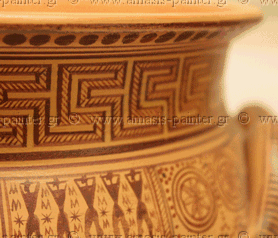Hellenic Pottery Painting
in Historical Times
|
Even at this stage, the “commercial” on the one hand and the ethical-philosophical on the other, vessels do not lose their sacredness. Mass production and widespread use do not diminish their value. Through them appears the open character of the original example of the State, and the sociopolitical role of art of an era that adores beauty in every aspect. (On the second day of the Anthestiria feast – Choes – every three- year-old boy celebrated his “entrance” to life by participating in the feast with his own - usually red figure-style – “Chou” etc.)
Religion, knowledge and power do not reside in the palace or the clergy any more but in Agora. The form of the statues reflects desire elements. Man was deified and gods were the nature and aspect of the human soul.
The bigger the demand for Greek vessels, from the rich markets of Etruria and other places in the known world of that time, the better the vessels were made (contrary to the market law), thus, transferring not only the glory of Athens but also the sacred substance stored within.
It is not right to compare the extensive exports of pottery with modern trade of artifacts since trade, during those times, was based on religious tradition (burial customs, ceremonies, rituals, etc) and products were limited in number and made with a lot of effort from primary materials.
Consequently, these products were unique and “alive” whether they were weapons (the renowned description of Achilles’ weapons by Homer) or they were vessels which were at the same time both secular and sacred* utensils.
For the sake of our study, we included vessels in the general cultural context of antiquity since they are the functional and living part of a different anthropologic example and a different everyday routine whose main element and priority was aesthetics and everyday life was an esthetic experience itself. Of course, since then the role of experience and knowledge has changed radically.
The language on the vessels is not legible at first sight. In order to appreciate them, we should familiarize ourselves with these and their world.
Above all, they are creations of human emotions, objects of everyday use and not formal cryptograms or information for our own -cynegetic, scientific- mentality. This is the context in which we should approach them, let them charm us in their own way and then we will understand that no other object is more human than a clay vessel, maybe because we are made from the same warm material as they are.






